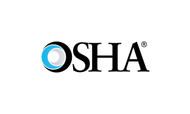Know Your OSHA Regulations
Posted by EnSafeCo on 5th Jun 2020
The term “hazardous materials” is both wide-ranging and self-explanatory. The materials are hazardous to someone or something! Unfortunately, just because something is hazardous doesn’t always mean it is handled with care. The improper management of hazardous materials jeopardizes the safety of a company’s workers and the environment.
As a result, hazardous materials storage, disposal, and clean-up are regulated by various federal & state agencies. The energy, transport, and construction sectors are typical industries which require strict regulatory compliance. While the Environmental Protection Agency’s (EPA) oversight in spill response might be obvious, many people often overlook the Occupational Health and Safety Administration’s (OSHA) involvement. For example, there are materials that may not be hazardous to the environment or people, but create hazardous workspaces when spilled. Soapy water itself is not hazardous, but it’s certainly a workplace hazard when spilled on the floor. Just ask any experienced prankster!
Overall, a workplace with proper spill management procedures will be cleaner and safer. Keep the below OSHA information in mind when managing hazardous materials.
What is Hazardous Material
Any biological, chemical, radiological or physical material that has the potential, by itself or through interacting with other factors, to harm animals, humans, or the environment is considered hazardous material.
Know Title 29 of the Code of Federal Regulations
Title 29 Code of the Federal Regulations - Subpart H (CFR29/H) is the backbone of the requirements for safety, training and disposal programs concerning HAZMAT materials. It is broken down into 9 sections.
1. Site Safety and Health Programs
Site safety and health programs must include a policy statement, means of communicating procedures and rules to employees, feedback procedures, emergency prevention measures and must be overseen by the site coordinator or other employer's representative.
2. Training
Training should cover types of hazards that might be encountered, outline appropriate clean-up procedures and provide hands-on training with drain covers, dewatering filter bags, Pipe filter socks and pieces of spill kits that employees might be called on to use in an emergency.
3. Decontamination
Decontamination procedures must be site-specific and outlined in detail.
4. Emergency Response Plans
Standard procedures should dictate all personal follow state and district emergency response plans.
5. Personal Protective Equipment (PPE)
Personnel should be regularly practiced in the use of site-specific PPE. Plans should also be in place to prevent possible harm that the PPE itself can present such as heat stress.
6. Incident Command System
An ICS is basically an organized plan that specifies who will be in command during an emergency and how they will communicate with team members.
7. Site Safety and Control Plans
The SSCP encompasses all the possible factors that could impact the safety of responders during an emergency. The "Occupational Safety and Health Guidance Manual for Hazardous Waste Site Activities" from NIOSH is a good place to start when compiling this plan which must be very detailed.
8. Spill Containment Requirements
OSHA's Spill Containment Requirements cover the majority of the hands-on procedures that must be followed such as inventory tracking, labeling, storage procedures, etc. It is a very involved section that should be studied closely.
9. Spill Kit Requirements
OSHA has very specific Spill Kit requirement depending on the types of hazards that are present. As an example, a Battery Acid Spill Kit contains very different components than an Oil Only Spill Kit.
From a single small company Ensafeco has grown to a multi-divisional firm dedicated to helping companies protect the environment and maintain regulatory compliance. Staffed by trained industry professionals with experience around the globe, they provide environmental, safety, and compliance products to meet most any need. They hope this information is useful to you and look forward to serving you in the future.

